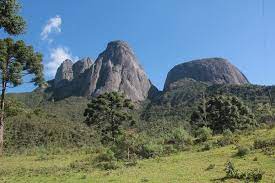MANEJO DA FLORA E ORDENAMENTO DO USO PÚBLICO EM ÁREA COSTEIRA DE PRESERVAÇÃO PERMANENTE NO DISTRITO DE TAMOIOS, CABO FRIO/RJ
Keywords:
Coastal vegetationAbstract
This work presents the applied actions for the recovery and management of coastal vegetation in the Permanent Preservation Area in the southern sector of the District of Tamoios, Cabo Frio/RJ. The activities focused on partial fencing the area, controlling dominant and invasive plant species, planting native species, removing garbage, and making educational signs. The removed monodominant species is Dalbergia echastopyllum, which has grown without control and does not favor the advancement of other species, especially Ipomoea pes-caprae. The result observed with the management is the rapid expansion of other herbaceous species that repent over the area, favored by the biomass of D. echastopyllum. The ipomoea pes-caprae largely occupies the post-beach zone and is moving to the reverse of the dune with speed. The cover of leaves and branches and the rapid expansion of vegetation do not leave the dune exposed to the action of strong winds. Future works predict an inventory of flora and fauna species in the recovered areas and the relationship between the expansion of D. ecastophyllum and increased temperature and rainfall. In this way, it aims to contribute to the proposal for the creation, zoning, and norms of a Unit of Conservation that must guide the use of the area and its management, in addition to the implementation of necessary physical structures in the coastal vegetation.
Downloads
References
ALENCAR, M.C.; OLDONI, T.L.C.; CASTRO, M.L.; CABRAL, I.S.R.; COSTA-NETO, E.S.; CURY, J.A.; ROSALEN, P.L. e IKEGAKI, M. (2007) Chemical composition and biological activity of a new type of Brazilian propolis: red propolis. J. Ethnopharmacol, v. 113, p. 278-283.
ARAÚJO, D.S.D. e ENRIQUES, R.P.B. (1984) Análise florística das restingas do Estado do Rio de Janeiro. Restingas: origens, estrutura, processos. Niterói, CEUFF. p. 159-193.
ARAÚJO, J.M.E.; SANTOS, L.; MENDONÇA-MELO, E.; DIVINO, A.; FERNANDES, R.P.M. e SCHER, R. (2018) Phenolic composition and leishmanicidal activity of red própolis and dalbergia ecasthoppylum (L.) Taub (Fabaceae) extracts from Sergipe, Brazil. Human and Animal Health, v. 61.
BOHER, C.B.A.; DANTAS, H.G.R.; CRONEMBERGER, F.M.; VICENS, R.S. E ANDRADE, S.F. (2009) Mapeamento da vegetação e do uso do solo no centro de diversidade vegetal de Cabo Frio, Rio de Janeiro. Rodriguésia, v. 60, n. 1, p. 001-023.
BARATELLI, T.G.; CANDIDO GOMES, A.C.; WESSJOHANN, L.A.; KUSTER, R.M. e SIMAS, N.K. (2012) Phytochemical and allelopathic studies of Terminalia catappa L. (Combretaceae). Biochemical Systematics and Ecology, v. 41, p.119-125.
BULHÕES, E.; FERNANDEZ, G.; OLIVEIRA FILHO, S.R. e PEREIRA, T.G. (2016) Coastal impacts induced by storm waves between Cabo Frio and Búzios, Rio de Janeiro, Brazil. Journal of Coastal Research, v. 75, p. 1047-1051.
CAPATINTA, G.V.C.; MEJÍA, J.A.A.; TANIMOTO, M.H.; GROPPO, M.; SARMENTO, J.C.A. e BASTOS, J.K. (2020) Dalbergia ecasthoppylum (L.) Taub. and Symphonia globulifera L.f.: The botanical sources of isoflavonoids and benzophenones in brazilian red propolis. Molecules, v. 25, n. 9.
CARTER, R.W.G. (1986) The morphodynamics of beach-ridge formation: Magilligan, Northern Ireland. Marine Geology, v. 73, n. 3-4, p. 191-432.
CARVALHO, A.M. (1997) A synopsis of the genus Dalbergia (Fabaceae: Dalbergieae) in Brazil. Brittonia, v. 49, p. 87-109.
CASTELLANI, T.T.; PEIXOTO, J.R.V. e LOPES, B.C. (2004) Variação temporal da vegetação das dunas da Praia da Joaquina, Ilha de Santa Catarina. Anais da Semana Nacional de Oceanografia, Itajaí.
CASTELLANI, T.T.; SANTOS, F.A.M. (2006) Abundância, sobrevivência e crescimento de plântulas de Ipomoea pes-caprae (L.) R. Br. (Convolvulaceae) na Ilha de Santa Catarina, SC, Brasil. Acta Botanica Brasilica, Feira de Santana, v. 20, n. 4, p. 875-885.
CASTRO, L.Q.; ROCHA, T.B. e VIEIRA, R. (2020) Mapeamneto da linha de costa e avaliação da vulnerabilidade e susceptibilidade à erosão costeira entre a foz do rio São João e a foz do rio Uma, Cabo Frio, RJ. Arq. Cien. Mar. Fortaleza, v. 53 (Especial), p. 7-24.
COE, H.H.G.; CARVALHO, C.N.; SOUZA, L.O.F. e SOARES, A. (2007) Peculiaridades Ecológicas da Região de Cabo Frio, RJ. Revista de Tamoios, ano IV, n. 2.
DAVIDSON‐ARNOTT, R.; HESP, P., OLLERHEAD, J.; WALKER, I.; BAUER, B.; DELGADO-FERNANDEZ, I. e SMYTH, T. (2018) Sediment budget controls on foredune height: Comparing simulation model results with field data. Earth Surface Processes and Landforms, v. 43, n. 9, p. 1798-1810.
DECHOUM, M.; CASTELLANI, T.; ZILLER, S.; PLUCÊNIO, R.; SOUZA, V. e LOPES, J. (2015) Envolvimento comunitário e universitário na restauração da diversidade biológica. Revista Eletrônica de Extensão, ISSN 1807-0221. Florianópolis, v. 12, n. 19, p. 51-60.
DEVALL, M.S. (1987) Ecology of Ipomoea pes-caprae (Convolvulaceae) at Grand Isle, Louisiana. Proceedings of Louisiana Academy of Science, v. 50, p. 7-12.
DOYLE, T.B.; SHORT, A.D.; RUGGIERO, P. e WOODROFFE, C.D. (2019) Interdecadal Foredune Changes along the Southeast Australian Coastline: 1942-2014. Journal of Marine Science and Engineering, v. 7. n. 6, p. 177.
FABRICANTE, J.R.; CRUZ, A.B.S.; REIS, F.M. e ALMEIDA, T.S. (2021) Biological invasion in restinga sites in northeastern Brazil. Agrarian and Biological Sciences, v. 10, n. 6, p. e48410615942, 2021. DOI: 10.33448/rsd-v10i6.15942
FERNANDEZ, G.B. e MUEHE, D.A. (1998) Influência de sedimentos fluviais na morfologia da praia e antepraia no embaiamento Rio das Ostras - Cabo Búzios - RJ. Geosul, v. 14, n. 27, p. 200-203.
GABAY, O.; PEREVOLOTSKY, A. e SHACHAK, M. (2012) How landscape modulators function: woody plant impact on seed dispersal and abiotic filtering. Plant Ecology, v. 213, p. 685-693
HART, T.B.; HART, J.A. e MURPHY, P.G. (1989) Monodominant and species-rich forests of the humid tropics: causes for their co-occurrence. American Naturalist, v. 133, p. 613-633.
HESP, P.A. (2000) Coastal sand dunes: form and function. CDVN Technical Bulletin, v. 4, p. 28.
HESP, P.A. e WALKER, I.J. (2013) Coastal Dunes. In: JOHN F. S (Ed.). Treatise on Geomorphology. San Diego: Academic Press. p. 328-355.
HOLZER, W.; CRICHYNO, J. e PIRES, A.C. (2004) Sustentabilidade da urbanização em áreas de restinga: uma proposta de avaliação pós-ocupação. Paisagem Ambiente, v. 19, p. 49-66.
INAGUE, G.M.; ZWIENER, V.P. e MARQUES, M.C.M. (2021) Climate change threatens the woody plant taxonomic and functional diversities of the restinga vegetation in Brazil. Perspectives in Ecology and Conservation, v. 19, p 53-60.
IPCC – Inetergovernmental Panel on Climate Change. (2021) Summary for Policymakers. In: Climate Change 2021: The Physical Science Basis.
LIMA, L.A.; MACHADO, D.V.; SABINO, H. e MENEZES, J. (2020) Caracterização hidrogeoquímica e isotópica do aquífero costeiro do Distrito de Tamoios, Cabo Frio, RJ. Anuário do Instituto de Geociências, UFRJ, v. 43, n. 4, p. 218-228.
MARQUES, O.A.V. e DULEBA. V. (2004) Estação Ecológica Juréia-Itatins - Ambiente físico, flora e fauna. Editora Holos, Ribeirão Preto.
MARTIN, L.; SUGUIO, K.; DOINGUEZ, J.M.L. e FLEXOR, J.M. (2012) Geologia do Quaternário costeiro do litoral norte do Rio de Janeiro e do Espírito Santo. São Paulo, FAPESP/CPRM (Escala 1200.000 e texto explicativo).
MATA, V.P.; COSTA, M.A.P.C.; MORAIS, D.V. e CARVALHO, C.A.L. (2014) Germinação de sementes de Dalbergia ecastaphyllum (L.) Taubert sob diferentes temperaturas. Enciclopédia Biosfera, Goiânia, v. 10, n. 18, p.1832-1844.
MENDONÇA-MELO, L.; MOTA, E.; LOPEZ, B.; SAWAYA, A.; FREITAS, L.; JAIN, S.; BATISTA, M. e ARAÚJO, E. (2017) Chemical and genetic similarity between Dalbergia ecasthoppylum and red propolis from the Northeastern Brazil. Journal od Apicultural Research, v. 56, n. 1, p. 32-39.
MOURA, N.S.V.; MORAN, E.F.; STROHAECKER, T.M. e KUNS, A.V. (2015) A Urbanização na Zona Costeira: Processos locais e regionais e as transformações ambientais - o caso do Litoral Norte do Estado do Rio Grande do Sul, Brasil. Ciência e Natura, v. 37, n. 42, p. 594-612.
MUEHE, D.; FERNANDEZ, G.B.; BULHÕES, E. e AZEVEDO, I.F. (2011) Avaliação da vulnerabilidade física da orla costeira em nível local, tomando como exemplo o arco praial entre Rio das Ostras e o Cabo Búzios, RJ. Revista Brasileira de Geomorfologia, v. 12, n. 2, p. 45-58.
PEIXOTO, J.R.V.; HORN-FILHO, N.O.; CASTELLANI T.T. e OLIVEIRA, U.R. (2006) Summer variations of the morphology and the pionner vegetation of the foredune in the Santinho Beach, Santa Catarina Island, SC, Brazil. Journal of Coastal Research, v. 39, p. 622-625.
PEIXOTO, J.R.V. (2010) Interação praia-duna e sua influência sobre a vegetação de duna frontal na costa leste da ilha de Santa Catarina, SC. Tese de Doutorado, Programa de Pós-graduação em Geografia, UFSC, 175p.
PLUCÊNIO, R.M.; DECHOUM, M.S. e CASTELLANI, T.T. (2013) Invasão biológica em restinga: o estudo de caso de Terminalia catappa L. (Combretaceae). Biodiversidade Brasileira, v. 3, n. 2, p. 118-136.
RAN1 - Primeiro Relatório de Avaliação Nacional sobre Mudanças Climáticas, Base científica das mudanças climáticas. (2013). Disponível em: <http://www.pbmc.coppe.ufrj.br/index.php/pt/publicacoes/relatorios-pbmc/item/base-cientifica-das-mudancas-climaticas-volume-1-completo?category_id=18>. Acessado em: 03 nov. 2021.
RICHARDSON, D.M. e REJMÁNEK, M. (2011) Trees and shrubs as invasive alien species – a global review. Diversity and Distributions, v. 17, p. 788-809.
RUGGIERO, P.; HACKER, S.; SEABLOOM, E. e ZARNETSKE, P. (2018) The role of vegetation in determining dune morphology, exposure to sea-level rise, and storm-induced coastal hazards: a US Pacific Northwest perspective. In: Barrier Dynamics and Response to Changing Climate. Springer, p. 337-361.
SOUZA, P.Z. (2010) Dinâmica espaço-temporal de Dalbergia ecastophyllum (L.) Taub. em restinga no sul do Brasil. Programa de Pós-Graduação em Ecologia, Dissertação de mestrado, Universidade Federal de Santa Catarina, 118 p.
SOUZA, P.Z. (2016) Efeitos de manchas monodominantes sobre a organização e estrutura de comunidades vegetais em restinga subtropical. Programa de Pós-Graduação em Ecologia, Tese de Doutorado, Universidade Estadual de Campinas, 105 p.
SUGUIO, K. (2003) Geologia Sedimentar. Edgard Blucher, São Paulo, 416 p.
VIEIRA, R.; MONTEZUMA, R.C.M. e VALLEJO, L.R. (2019a) Projeto de envolvimento da comunidade local para recuperação e manejo da vegetação de restinga no Setor Sul de Tamoios, Cabo Frio, RJ. In: (FILHO, J.R.F., ASHLEY, P.A., CORRÊA, M.M. (Org.). Educação Ambiental, Sustentabilidade e Desenvolvimento Sustentável. Contribuições para o Ensino de Graduação. Eduff, Niterói, p. 625-648.
VIEIRA, R.; CHAMBERLAIN, I.M.M. e MONTEZUMA, R.C.M. (2019b) Capacidade de carga física e qualidade recreacional das praias do setor sul do Distrito de Tamoios, Cabo Frio, RJ. Uso Público em Unidades de Conservação, v. 7, n. 11, p. 42-62.
WANG, R.L.; ZENG, R.S.; PENG, S.L.; MCHEN, B.; LIANG, X.T. e WXIN, X. (2011) Elevated temperature may accelerate invasive expansion of the liana plant Ipomoea cairica. Weed Research, v. 51, p. 574-580.
ZIMMERMANN, T.G. (2012) Contaminação das Restingas por Casuarina equisetifolia L.: Atributos biológicos que limitam à regeneração natural da vegetação. Programa de Pós-graduação em Botânica Diversidade Vegetal: Conhecer e Conservar. Instituto de Pesquisa Jardim Botânico do Rio de Janeiro. Escola Nacional de Botânica Tropical, 26 p.




